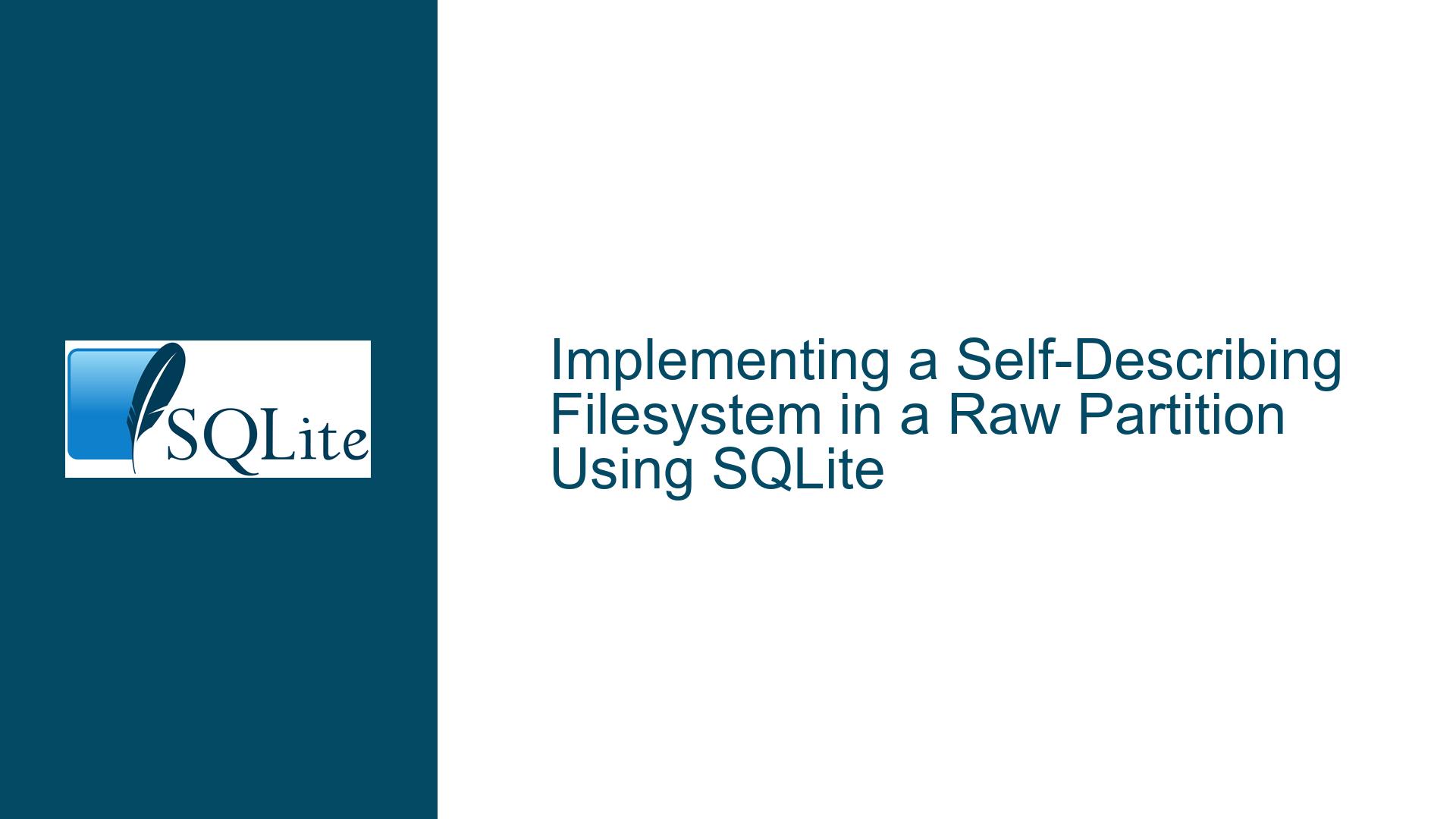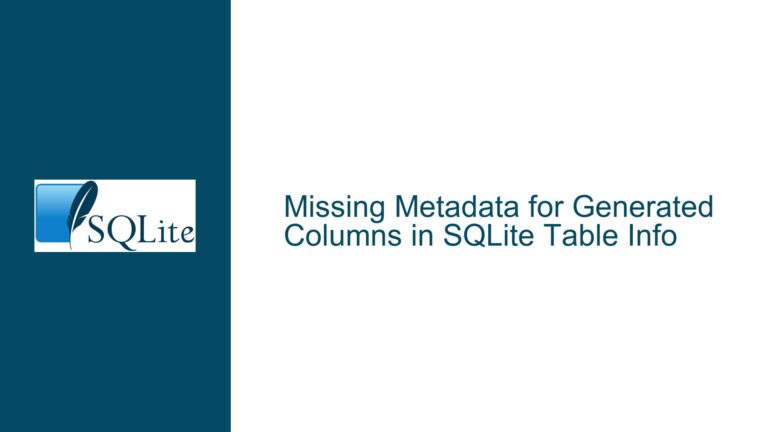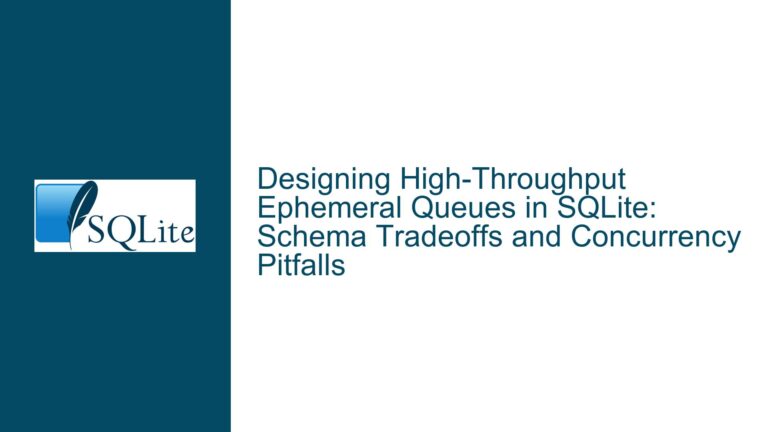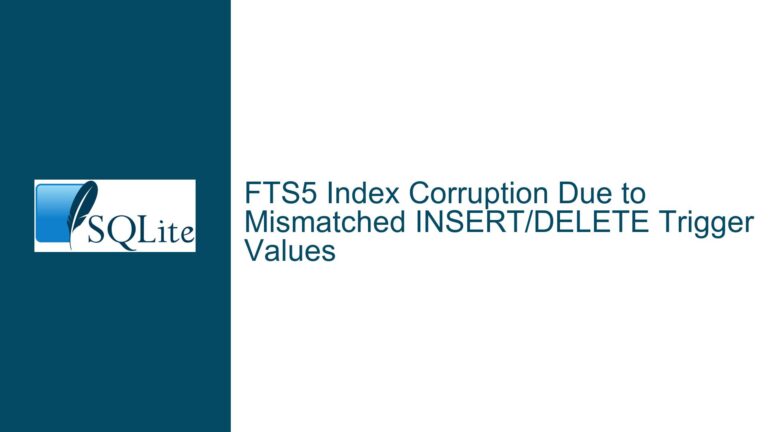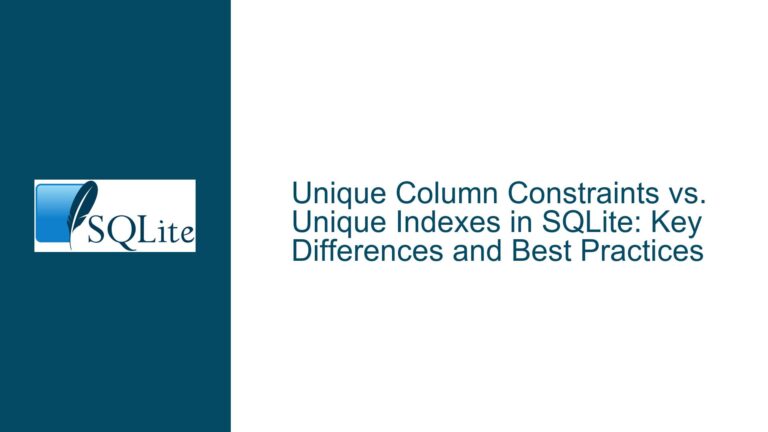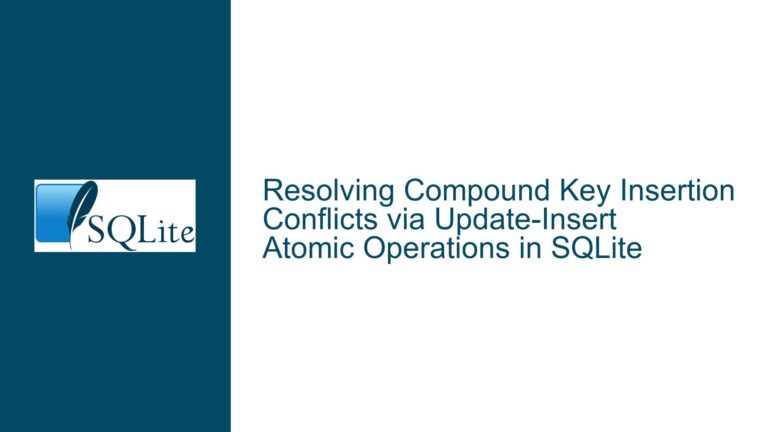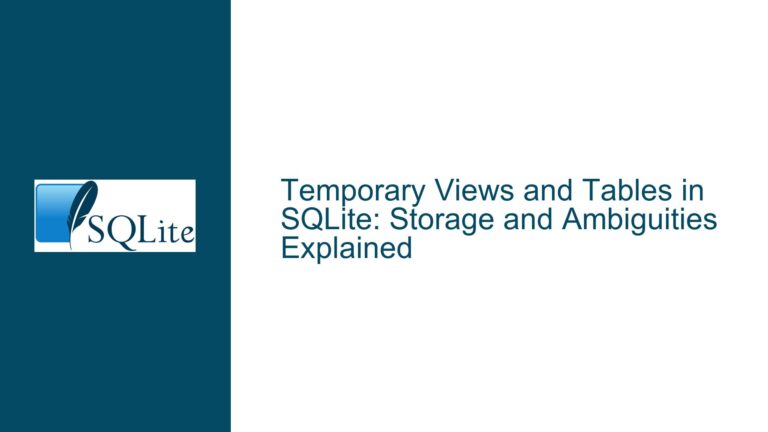Implementing a Self-Describing Filesystem in a Raw Partition Using SQLite
Metadata Management in a Self-Describing SQLite-Based Filesystem
The core issue revolves around designing a filesystem where metadata is stored in an SQLite database that resides within the same raw partition as the files it describes. This creates a recursive problem: the SQLite database must manage its own metadata while also managing the metadata of other files in the partition. This self-referential design introduces challenges in handling dynamic growth, file creation, and transaction management within the SQLite database.
The SQLite database must store metadata about the filesystem’s blocks, including free blocks, file allocations, and directory structures. However, when the database itself grows (e.g., due to rebalancing B-trees or adding new pages), it requires updating its own metadata. This recursive dependency creates a chicken-and-egg problem: updating the database requires updating the metadata, which in turn requires updating the database.
Additionally, the SQLite database must handle temporary files, such as journals or WAL (Write-Ahead Logging) files, which are essential for transaction management. These temporary files must also reside within the same raw partition, further complicating the design. The database must ensure that these files do not conflict with the primary metadata or user files, while also adhering to SQLite’s limitations on file size, naming, and growth.
Recursive Metadata Updates and Dynamic Growth Challenges
One of the primary challenges in this design is managing recursive metadata updates. When the SQLite database grows, it must allocate new blocks within the raw partition. These new blocks must be recorded in the database’s metadata, which itself is stored within the database. This creates a loop where updating the metadata requires additional metadata updates, potentially leading to infinite recursion or deadlock.
Dynamic growth of the SQLite database also poses significant challenges. SQLite supports large databases, with a theoretical maximum size of 256 TB for 64 KB pages. However, managing such large databases within a raw partition requires careful planning. The database must pre-allocate space to avoid fragmentation and ensure that it can grow without conflicting with user files. This pre-allocation must be flexible enough to accommodate future growth while minimizing wasted space.
Temporary files, such as WAL files and journals, further complicate the design. These files are essential for SQLite’s transaction management but can grow unpredictably during large transactions. The filesystem must ensure that these temporary files do not exhaust available space or interfere with user files. This requires implementing mechanisms to monitor and control the growth of temporary files, potentially by limiting their size or reserving dedicated space for them.
Solutions for Recursive Metadata and Dynamic Growth
To address the recursive metadata problem, the filesystem can implement a two-phase update mechanism. In the first phase, the database updates its metadata in a temporary "overflow area" outside the main metadata table. Once the transaction is complete, the changes are moved to the main metadata table. This approach avoids infinite recursion by decoupling the metadata updates from the primary database operations. However, it introduces additional complexity in managing the overflow area and ensuring data consistency.
For dynamic growth, the filesystem can adopt a hybrid approach combining static and dynamic allocation. A portion of the raw partition can be statically allocated for the SQLite database, similar to the inode table in traditional filesystems. This static allocation ensures that the database has a fixed amount of space to grow without conflicting with user files. The remaining space can be dynamically allocated as needed, with the database managing free blocks and file allocations.
To handle temporary files, the filesystem can implement dedicated space reservations. A portion of the raw partition can be reserved exclusively for temporary files, ensuring that they do not interfere with user files or exhaust available space. The database can monitor the size of temporary files and enforce limits to prevent excessive growth. Additionally, the filesystem can implement mechanisms to clean up temporary files after transactions are complete, freeing up space for future use.
File Creation and Naming Constraints in SQLite
SQLite imposes certain limitations on file creation and naming that must be considered in this design. The database can create multiple files for a single database, including the main database file, WAL files, and journals. The filesystem must ensure that these files are properly managed within the raw partition, with unique names and sufficient space for growth.
File naming is another critical consideration. SQLite allows filenames up to 255 bytes in length, but the filesystem must ensure that these names are unique and do not conflict with user files. The VFS (Virtual File System) layer must provide a mechanism for generating and managing filenames, potentially using a combination of unique identifiers and hierarchical naming schemes.
Addressing SQLite’s File Size Limitations
SQLite’s file size limitations must also be addressed in this design. While SQLite supports large databases, the filesystem must ensure that the database does not exceed the available space in the raw partition. This requires implementing mechanisms to monitor and control the size of the database, potentially by enforcing size limits or implementing compression techniques.
The filesystem must also handle the growth of temporary files, such as WAL files and journals. These files can grow significantly during large transactions, potentially exhausting available space. The filesystem can implement mechanisms to limit the size of temporary files or reserve dedicated space for them, ensuring that they do not interfere with user files or the primary database.
Parallelism and Transaction Management
SQLite’s single-writer model simplifies transaction management but introduces challenges in a multi-user environment. The filesystem must ensure that transactions are properly serialized to avoid conflicts and ensure data consistency. This requires implementing mechanisms to manage concurrent access to the database, potentially by using locks or other synchronization techniques.
The filesystem must also handle transaction rollbacks and recovery in the event of failures. SQLite’s WAL mode provides robust transaction management, but the filesystem must ensure that the WAL files are properly managed within the raw partition. This includes implementing mechanisms to clean up WAL files after transactions are complete and ensuring that they do not exhaust available space.
Conclusion
Designing a self-describing filesystem in a raw partition using SQLite presents unique challenges in metadata management, dynamic growth, file creation, and transaction management. By implementing a two-phase update mechanism, hybrid allocation strategies, and dedicated space reservations, the filesystem can address these challenges and provide a robust and scalable solution. Careful consideration of SQLite’s limitations and the recursive nature of the design is essential to ensure data consistency and optimal performance.
